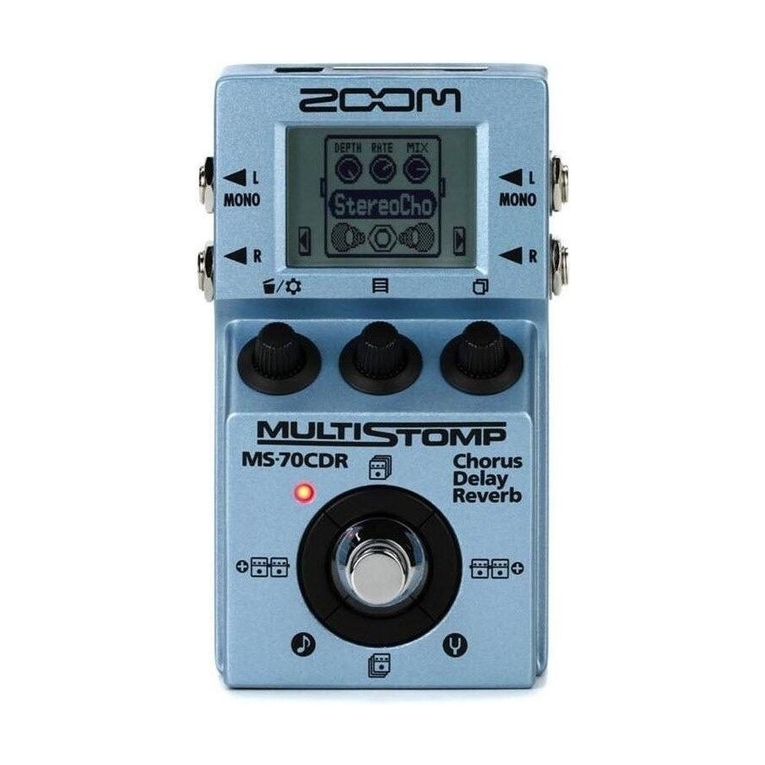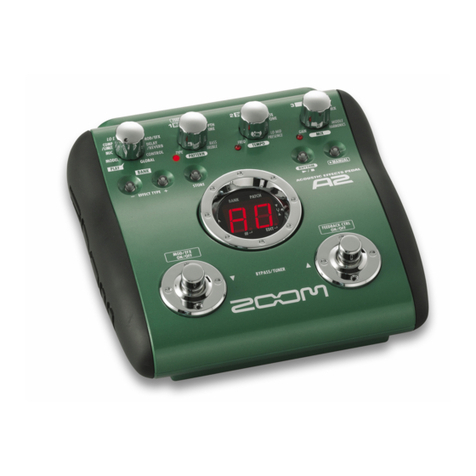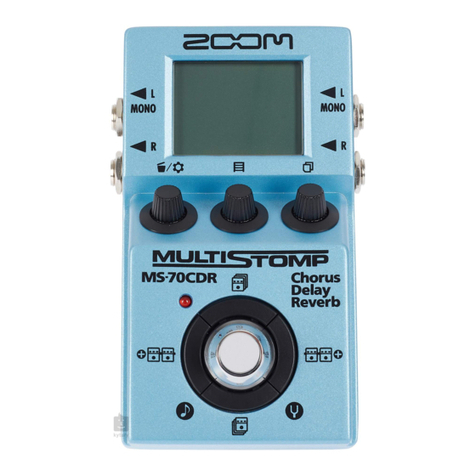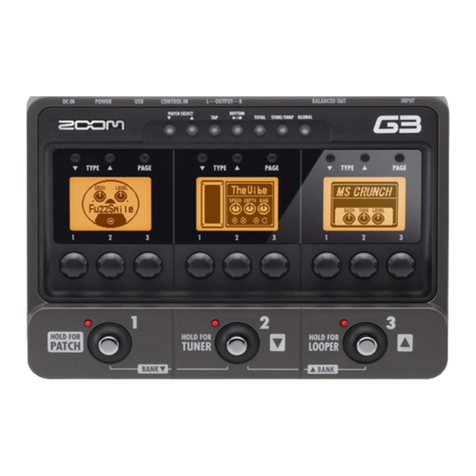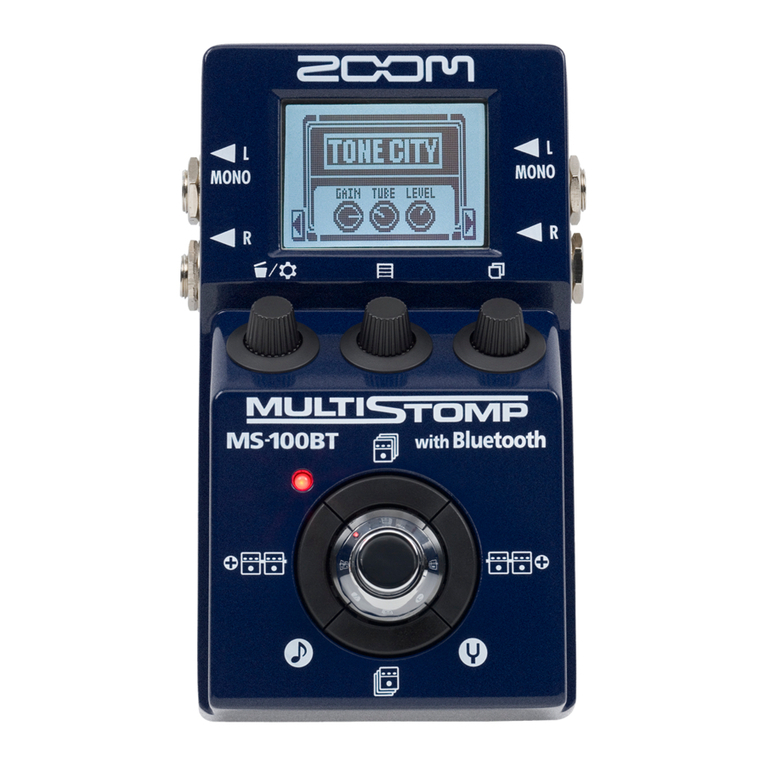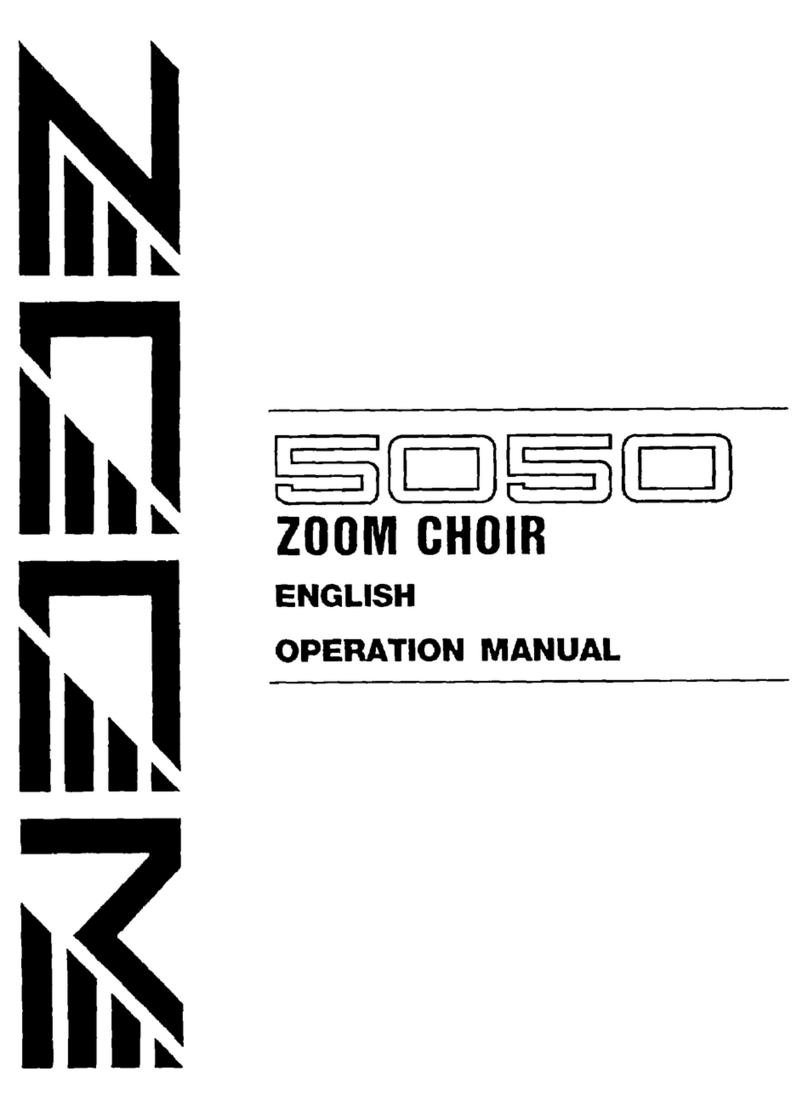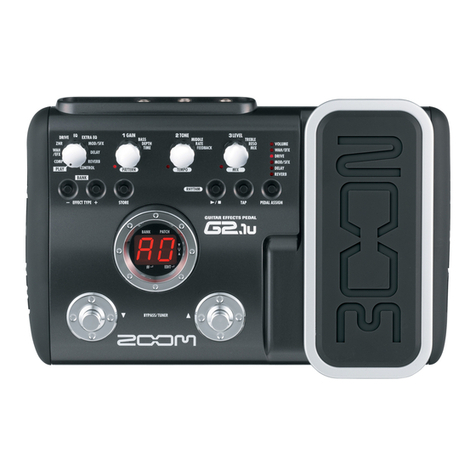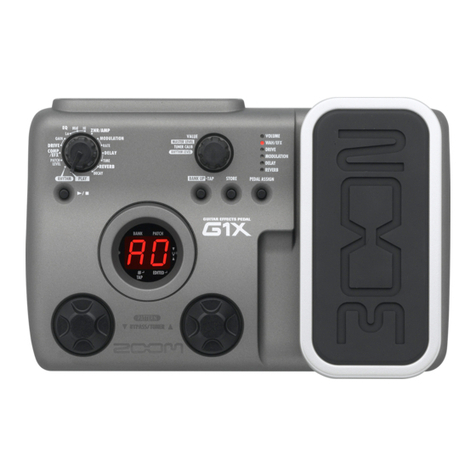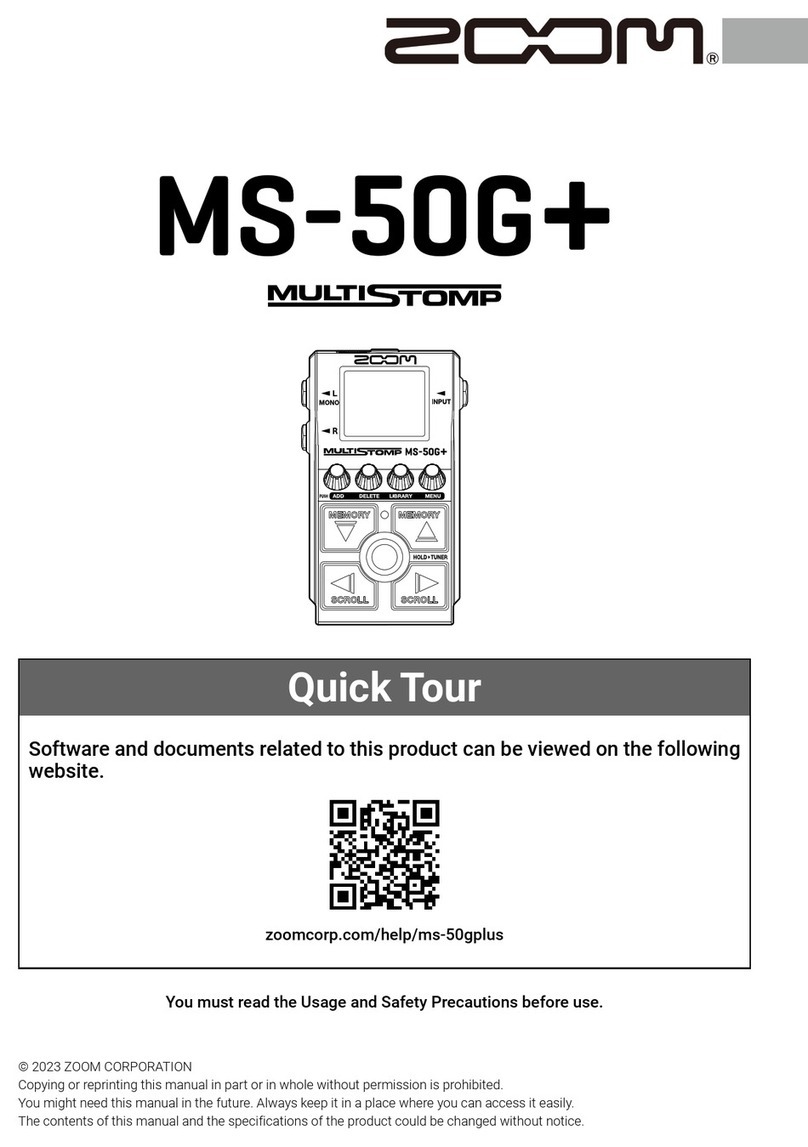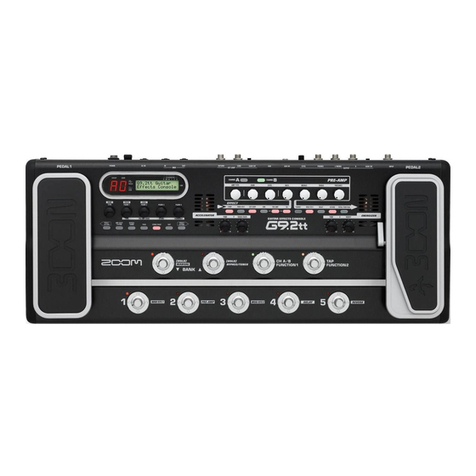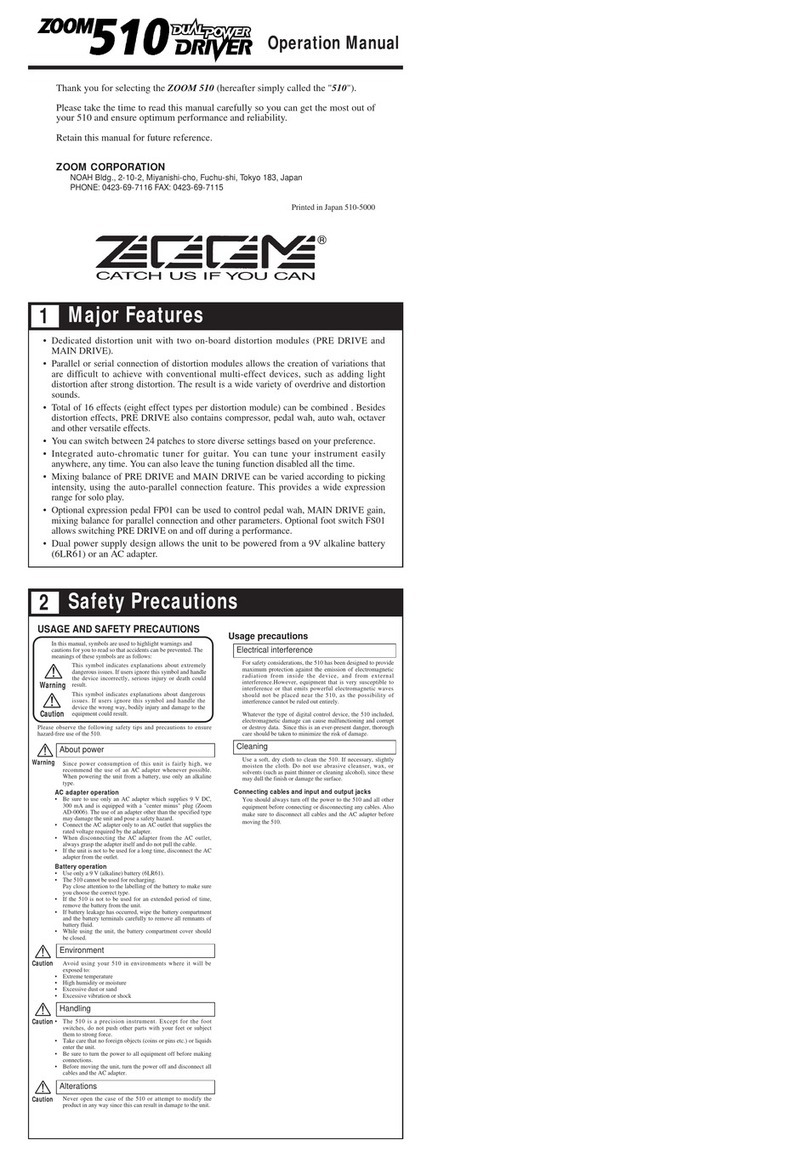Zoom B2.1u User manual

Operation Manual
© ZOOM Corporation
Reproduction of this manual, in whole or in part,
by any means, is prohibited.

ZOOM B2.1u
2
SAFETY PRECAUTIONS
In this manual, symbols are used to highlight warnings and
cautions for you to read so that accidents can be prevented. The
meanings of these symbols are as follows:
This symbol indicates explanations about extremely
dangerous matters. If users ignore this symbol and
handle the device the wrong way, serious injury or
death could result.
This symbol indicates explanations about dangerous
matters. If users ignore this symbol and handle the
device the wrong way, bodily injury and damage to
the equipment could result.
Please observe the following safety tips and precautions to
ensure hazard-free use of the B2.1u.
Power requirements
Since power consumption of this unit is fairly high, we
recommend the use of an AC adapter whenever
possible. When powering the unit from batteries, use
only alkaline types.
[AC adapter operation]
•Be sure to use only an AC adapter which supplies 9 V DC,
300 mA and is equipped with a "center minus" plug
(Zoom AD-0006). The use of an adapter other than the
specified type may damage the unit and pose a safety
hazard.
•Connect the AC adapter only to an AC outlet that supplies
the rated voltage required by the adapter.
• When disconnecting the AC adapter from the AC outlet,
always grasp the adapter itself and do not pull at the cable.
• During lightning or when not using the unit for an
extended period, disconnect the AC adapter from the AC
outlet.
[Battery operation]
• Use four conventional IEC R6 (size AA) batteries
(alkaline).
• The B2.1u cannot be used for recharging.
•Pay close attention to the labelling of the battery to make
sure you choose the correct type.
• When not using the unit for an extended period, remove
the batteries from the unit.
• If battery leakage has occurred, wipe the battery
compartment and the battery terminals carefully to
remove all remnants of battery fluid.
• While using the unit, the battery compartment cover
should be closed.
Environment
To prevent the risk of fire, electric shock or
malfunction, avoid using your B2.1u in environments
where it will be exposed to:
• Extreme temperatures
• Heat sources such as radiators or stoves
• High humidity or moisture
• Excessive dust or sand
• Excessive vibration or shock
Handling
•Never place objects filled with liquids, such as vases, on
the B2.1u since this can cause electric shock.
•Do not place naked flame sources, such as lighted candles,
on the B2.1u since this can cause fire.
• The B2.1u is a precision instrument. Do not exert undue
pressure on the keys and other controls.Also take care not
to drop the unit, and do not subject it to shock or excessive
pressure.
•Take care that no foreign objects (coins or pins etc.) or
liquids can enter the unit.
Connecting cables and input and output
jacks
You should always turn off the power to the B2.1u and
all other equipment before connecting or disconnecting
any cables. Also make sure to disconnect all connection
cables and the power cord before moving the B2.1u.
Alterations
Never open the case of the B2.1u or attempt to modify
the product in any way since this can result in damage
to the unit.
Volume
Do not use the B2.1u at a loud volume for a long time
since this can cause hearing impairment.
Usage Precautions
Electrical interference
For safety considerations, the B2.1u has been designed to
provide maximum protection against the emission of
electromagnetic radiation from inside the device, and protection
from external interference. However, equipment that is very
susceptible to interference or that emits powerful
electromagnetic waves should not be placed near the B2.1u, as
the possibility of interference cannot be ruled out entirely.
With any type of digital control device, the B2.1u included,
electromagnetic interference can cause malfunctioning and can
corrupt or destroy data. Care should be taken to minimize the
risk of damage.
Cleaning
Use a soft, dry cloth to clean the B2.1u. If necessary, slightly
moisten the cloth. Do not use abrasive cleanser, wax, or solvents
(such as paint thinner or cleaning alcohol), since these may dull
the finish or damage the surface.
Please keep this manual in a convenient place for
future reference.
*Windows and Windows XP are registered trademarks of
Microsoft Corporation.
* Macintosh is a registered trademark of Apple Computer.
* All other product names, trademarks, and company names
mentioned in this manual are the property of their respective
owners.
W
arning
Caution
W
arning
W
arning
W
arning
Caution
W
arning
Caution
SAFETY PRECAUTIONS / Usage Precautions

ZOOM B2.1u
3
Contents
SAFETY PRECAUTIONS / Usage Precautions ................................ 2
SAFETY PRECAUTIONS .................................................................... 2
Usage Precautions .............................................................................. 2
Features .............................................................................................. 4
Terms Used in This Manual .............................................................. 5
Controls and Functions / Connections ........................................... 6
Selecting a Patch ............................................................................... 8
Using the Tuner ............................................................................... 10
Using the Rhythm Function ............................................................ 12
Editing a Patch ................................................................................. 14
Storing/Copying Patches ............................................................... 16
Using the Built-in Expression Pedal ............................................... 18
Other Functions................................................................................ 20
Making settings for the internal expression pedal .......................... 20
Adjusting the sensitivity of the built-in expression pedal ............... 20
Using an external expression pedal (FP01/FP02)............................ 21
Using a foot switch (FS01) ................................................................ 21
Using the B2.1u as audio interface for a computer......................... 22
Use as a direct box ........................................................................... 23
Restoring Factory Defaults ............................................................ 24
Linking Effects.................................................................................. 25
Effect Types and Parameters.......................................................... 26
How to read the parameter table ..................................................... 26
COMP/LIMIT................................................................................. 27
WAH/EFX ...................................................................................... 27
DRIVE/SYNTH ............................................................................... 29
ZNR/MIX ....................................................................................... 30
LO EQ ........................................................................................... 30
HI EQ............................................................................................. 31
MOD/SFX ...................................................................................... 31
DELAY ........................................................................................... 33
REVERB ........................................................................................ 33
CONTROL..................................................................................... 34
Specifications .................................................................................. 35
Troubleshooting .............................................................................. 35
B2.1u Preset Pattern ............................................................
Back cover
The FCC regulation warning (for U.S.A.)
This equipment has been tested and found to comply with the limits for a Class B digital device, pursuant to Part
15 of the FCC Rules. These limits are designed to provide reasonable protection against harmful interference in a
residential installation. This equipment generates, uses, and can radiate radio frequency energy and, if not
installed and used in accordance with the instructions, may cause harmful interference to radio communications.
However, there is no guarantee that interference will not occur in a particular installation. If this equipment does
cause harmful interference to radio or television reception, which can be determined by turning the equipment
off and on, the user is encouraged to try to correct the interference by one or more of the following measures:
• Reorient or relocate the receiving antenna.
• Increase the separation between the equipment and receiver.
• Connect the equipment into an outlet on a circuit different from that to which the receiver is
connected.
• Consult the dealer or an experienced radio/TV technician for help.

ZOOM B2.1u
4
Features
Thank you for selecting the
ZOOM B2.1u
(hereafter simply called the "
B2.1u
"). The B2.1u is a multi
effect processor with the following features and functions.
●
Latest technology for outstanding performance
96 kHz / 24 bit sampling (with 32 bit internal processing) assures excellent sound quality. The B2.1u
carves out a sonic outline in superb detail while preserving the original sound character of the bass guitar.
The B2.1u also has a USB connection and can be used as a direct bass guitar/computer interface.
●
Versatile palette of effects
Out of a total of 47 effects, up to nine (including ZNR) can be used simultaneously. The dazzling choices
provided by the B2.1u include distortion effects modeled on famous amps and compact effects, compressor/
limiter effects for dynamic punch, a parametric equalizer essential for working on sonic nuances, as well as
various delay and modulation effects. Both in quality and versatility, the B2.1u far surpasses anything in its
class. You can even transform the output into a cool synth bass or fretless bass sound.
●
Really usable patches straight out of the box
Effect module combinations are stored and called up in units referred to as patches. The B2.1u comes
with a full complement of 40 read-only plus 40 user-programmable patches, giving you 80 great reasons
to start grooving.
●
Great for live performances and direct recording
The distortion effects have a special parameter that selects whether to apply only the head amp
characteristics or add also the cabinet sound. This lets you use the B2.1u effectively not only for a live
performance but also when feeding the signal directly to a recorder.
●
XLR connector for direct output
In addition to the [OUTPUT/PHONES] jack, the B2.1u features an XLR connector for sending a
balanced line-level signal to equipment such as a PA mixer or recording console. The signal can be
derived from a point before or after effect processing. A ground lift switch is also provided, which is
useful to prevent hum in the direct output caused by ground loops.
●
Integrated auto-chromatic tuner and rhythm functions
Realistic PCM sound sources are available to auto-play a number of rhythm patterns. This is convenient
for use as a metronome during practice or to provide a simple rhythm part for a quick session. An auto-
chromatic tuner for bass guitar is also built right into the unit, including a function for silent tuning
which lets you easily tune your instrument on stage.
●
Sophisticated user interface
The combination of a rotary type selector and three parameter knobs make the effect editing process
intuitive and quick. The mute interval when switching patches has been reduced to less than 8
milliseconds. Seamless patch changing is now a reality.
●
Dual power supply principle allows use anywhere
The B2.1u can be powered from four IEC R6 (size AA) batteries or an AC adapter. Continuous
operating time on batteries is approximately 6 hours with alkaline batteries.
●
Easy operation with expression pedal and foot switch
An optional foot switch (FS01) or expression pedal (FP01/FP02) can be connected to the [CONTROL
IN] jack. The foot switch is convenient for quickly toggling effect programs, setting the tempo of the
rhythm function, turning delay hold on and off, etc. A connected expression pedal lets you adjust the
volume in real time.
Please take the time to read this manual carefully so as to get the most out of the unit and to ensure
optimum performance and reliability.

ZOOM B2.1u
5
Operating the B2.1u on batteries
Turn the B2.1u over and open the cover
of the battery compartment on the bottom.
B2.1u
bottom view
Latch
Latch
Cover Press the latch to release
it and then raise the cover.
1.
Insert four fresh IEC
R6 (size AA) batteries.
2.
Close the cover of
the battery compartment.
3.
Four IEC R6
(size AA) batteries
Insert batteries facing
in alternate directions.
Use four IEC R6 (size AA) batteries.
When the batteries are getting low, the
indication "bt" appears on the display.
Push the cover in until the
latch audibly snaps into
place.
LO EQZNR/MIXDRIVE/SYNTHCOMP/LIMIT WAH/EFX MOD/SFXHI EQ DELAY REVERB
IN OUT
Terms Used in This Manual
This section explains some important terms that are used throughout the B2.1u documentation.
■
Effect module
As shown in the illustration above, the B2.1u can be
thought of as a combination of several single effects.
Each of these effects is referred to as an effect module.
In addition to modules comprising compressor and
limiter effects (COMP/LIMIT), amp simulator/synth
bass effects (DRIVE/SYNTH), and modulation/special
effects (MOD/SFX), the B2.1u also provides a module
for ZNR (ZOOM Noise Reduction). Various
parameters such as effect intensity can be adjusted for
each module individually, and modules can be
switched on and off as desired.
■
Effect type
Within some effect modules, there are several
different effects which are referred to as effect types.
For example, the modulation/SFX effect module
(MOD/SFX) comprises chorus, flanger, pitch shifter,
delay, and other effect types. Only one of these can
be selected at a time.
■
Effect parameter
All effect modules have various parameters that can
be adjusted. These are called effect parameters.
In the B2.1u, effect parameters are adjusted with the
parameter knobs 1 – 3. Similar to the knobs on a
compact effect, these change aspects such as tonal
character and effect intensity. Which parameter is
assigned to each knob depends on the currently
selected effect module and effect type.
■
Patch
In the B2.1u, effect module combinations are stored
and called up in units referred to as patches. A patch
comprises information about the on/off status of each
effect module, about the effect type used in each
module, and about effect parameter settings. The
internal memory of the B2.1u holds up to 80 patches
(including 40 patches which allow read/write).
■
Bank and area
A group of ten patches is called a bank. The memory
of the B2.1u comprises a total of eight banks,
labelled A to d and 0 to 3. Banks A – d form the user
area which allows read/write. Banks 0 to 3 are the
preset area containing read-only patches.
The patches within each bank are numbered 0
through 9. To specify a patch of the B2.1u, you use
the format "A1" (patch number 1 from bank A), "06"
(patch number 6 from bank 0), etc.
■
Play mode/edit mode
The internal status of the B2.1u is referred to as the
operation mode. The two major modes are "play
mode" in which you can select patches and use them
for playing your instrument, and "edit mode" in
which you can modify the effects. The module
selector serves for switching between the play mode
and edit mode.

ZOOM B2.1u
6
Controls and Functions / Connections
Module selector Top Panel
Rear Panel
Switches between play mode and edit mode. In edit
mode, the knob selects the module for operation.
[W]/[Q] foot switches
These switches are used for selecting patches,
switching effect modules on and off, controlling
the tuner, and other functions.
[USB] connector
Allows you to connect the B2.1u. to a
computer, for exchanging audio data.
[BALANCED OUT] connector
This XLR connector can be used to
send a balanced line-level signal to
PA equipment, recording devices, or
similar.
[PRE/POST] switch
Selects the point where the signal supplied
at the [BALANCED OUT] connector is
obtained. In the "POST" position (switch
engaged), the signal is branched at a point
after effect processing, and in the "PRE"
position (switch disengaged), it is branched
at a point before effect processing.
[GROUND] switch
Determines whether the [BALANCED OUT]
connector is grounded or not. In the "LIFT"
position (switch engaged), the ground pin of
the [BALANCED OUT] connector is
uncoupled from the signal path. In the
"CONNECT" position (switch disengaged),
the ground pin is connected.
[STORE] key
Serves for storing edited patches in memory.
Computer
Mixer
BANK [-]/[+] keys
In play mode, the keys serve for directly switching
to the next lower or higher bank.
In edit mode, the keys switch the effect type for the
currently selected module.

Controls and Functions / Connections
ZOOM B2.1u
7
Parameter knobs 1 - 3
These knobs allow changing the level of effect parameters or of
the overall patch. During rhythm playback, the knobs let you select
a pattern, set the tempo, and adjust the rhythm volume.
[TAP] key
Allows manual input of time related effect parameter values such
as delay time, and rhythm pattern tempo.
Display
Shows patch numbers, setting values, and other information about
operating the B2.1u.
[PEDAL ASSIGN] key
This key lets you select the function of the built-in expression
pedal. The currently selected function is shown by a lit LED.
Expression pedal
Lets you adjust the volume or various effect parameters in real
time during play.
[CONTROL IN] jack
Serves for connection of the optional foot switch
(FS01) or expression pedal (FP01/FP02).
[DC IN] jack
An AC adapter (ZOOM AD-0006)
with a rated output of 9 volts DC,
300 mA (center minus plug) can
be plugged into this jack.
[POWER] switch
Turns the unit on and off.
RHYTHM [R/P] key
Serves to start/stop rhythm playback.
[OUTPUT/PHONES] jack
Bass Guitar
Bass Guitar amplifiers
Headphones
This stereo phone jack serves for connection to the bass
guitar amplifier or for monitoring with headphones. It is
also possible to use a Y cable for sending the output to
two amplifiers, to produce a spacious stereo effect sound.
[INPUT] jack
Serves for connecting the bass guitar.
AC adapter
FP01/FP02
FS01

ZOOM B2.1u
8
Selecting a Patch
A1
HINT
Turn power on
Set the B2.1u to play mode
Use a shielded cable with mono phone plug
to connect the bass guitar to the [INPUT]
jack of the B2.1u.
When using the B2.1u with the AC
adapter, plug the adapter into the outlet
and plug the cable from the adapter into
the [DC IN] jack on the B2.1u.
Turn the bass guitar amplifier on and
adjust the volume to a suitable position.
If the Module selector is set to a position
other than "PLAY", set it to "PLAY".
The bank and patch
that were selected
when the power was
last turned off will
appear on the display.
Select a patch
To switch the patch, press one of the [W]/[Q] foot switches.
Pressing the [W] foot switch calls up the next lower patch, and pressing the [Q] foot
switch calls up the next higher patch.
Repeatedly pressing one foot switch cycles through patches in the order A0 – A9 ... d0 – d9
→00 – 09 ... 30 – 39 →A0, or the reverse order.
Immediately after turning the B2.1u on,
the unit will be in play mode, even if the
Module selector is set to a position other
than "PLAY".
Set the [POWER] switch on the rear
panel of the B2.1u to ON.
Bank name Patch number
To try out the various effects of the B2.1u, we recommend that you simply play your instrument while
switching patches.

Selecting a Patch
ZOOM B2.1u 9
Adjust tone and volume
To adjust the effect sound and volume levels in
play mode, the Parameter knobs 1 – 3 can be
used. Each knob controls a specific parameter.
When you turn a Parameter knob, the corresponding
LED lights up and the display briefly shows the
current value of the respective parameter.
NOTE • If the DRIVE/SYNTH module is set to OFF
for the currently selected module
(indication "oF" is shown on the display),
Parameter knobs 1 and 2 have no effect.
• The higher the setting value of Parameter
knob 1 (CABINET parameter), the more
will the cabinet character be
emphasized.
• Changes made here are temporary and
will be lost when you select another
patch. To retain the changes, store the
patch in the user area.
• The master level in common to all
patches is set in edit mode (→p. 34).
Parameter knob 2
Parameter knob 1
Parameter knob 3
Adjusts the CABINET
parameter of the
DRIVE/SYNTH module
(cabinet simulator
effect intensity).
Adjusts the PATCH
LEVEL parameter (output
level of the entire patch).
Adjusts the TONE parameter of the DRIVE/SYNTH
module (mainly distortion sound character).
Directly selecting a bank
To select the banks A – d, 0 – 3 directly, use the BANK [-]/[+] keys.
Pressing the BANK [-] key calls up the next lower bank, and pressing the BANK
[+] key calls up the next higher bank.

ZOOM B2.1u
10
Using the Tuner
A8
B P
MT
Switch to bypass or mute
Setting the B2.1u to the bypass
In play mode, press both [W]/[Q] foot
switches together briefly and release.
Setting the B2.1u to the mute state
In play mode, press both [W]/[Q] foot
switches together and hold for at least 1
second.
When you press both [W]/[Q] foot switches together while
playing your instrument, the bypass/mute condition is
activated. However, the sound may change momentarily
just before the condition is activated. This is because the
B2.1u switches to the next higher or lower patch when one
of the foot switches is pressed slightly earlier. (When you
cancel the bypass/mute condition, the original patch
number will be active again.)
This kind of behavior is not a defect. It is due to the very
high speed at which the B2.1u responds to patch
switching. To prevent the sound change caused by the
above condition, do not produce sound with your
instrument until the bypass/mute condition is fully
established.
Play the string to tune
Play the open string to tune,
and adjust the pitch.
The left side of the display shows the
note which is closest to the current pitch.
Patch change at bypass/mute
The B2.1u incorporates an auto-chromatic tuner. To use the tuner function, the built-in effects must be
bypassed (temporarily turned off) or muted (original sound and effect sound turned off).

Using the Tuner
ZOOM B2.1u 11
A8
4 0
42
NOTE
Pitch is high Pitch is correct
Indication turns faster the more
the pitch is off
Pitch is low
Tune other strings in the
same way.
The right side of the display shows a
symbol that indicates by how much
the tuning is off.
When you turn the B2.1u off and on
again, the reference pitch setting will be
reset to 40 (center A = 440 Hz).
Adjusting the reference pitch of the tuner
Return to play mode
Turn Parameter knob 1.
While the reference pitch value is shown, turn
Parameter knob 1 to adjust it.
Press one of the [W]/[Q] foot
switches.
If required, you can fine-adjust the reference pitch of the B2.1u tuner.
The default setting after power-on is center A = 440 Hz.
The current reference pitch is shown.
The adjustment range is 35 – 45 (center A = 435 to 445 Hz).
When you release the Parameter knob, the
display indication will return to the
previous condition after a while.

ZOOM B2.1u
12
NOTE
Set the B2.1u to play mode
If the Module selector is set to a position
other than "PLAY", set it to "PLAY".
Start the rhythm
function
Select a rhythm
pattern
To start the rhythm function, press
the RHYTHM [R/P] key.
To continuously switch rhythm
patterns, turn Parameter knob 1.
To select the next higher or next
lower rhythm pattern, press one of
the BANK [-]/[+] keys.
During rhythm playback, the
REVERB module is OFF.
The B2.1u has 40 built-in rhythm patterns.
For more information on the pattern contents,
see the back cover of this manual.
When the above steps are carried out, the
current rhythm pattern number (01 – 40) is
briefly shown on the display.
Using the Rhythm Function
The B2.1u has a built-in rhythm function that plays realistic drum sounds in various patterns. The rhythm
function is available in play mode or in the bypass/mute condition.

Using the Rhythm Function
ZOOM B2.1u 13
2 5
2040
Dot is shown
Tempo = 120 BPM Tempo =240 BPM
Dots are shown
Adjust the rhythm volume
To adjust the rhythm volume, turn
Parameter knob 3.
Adjust the tempo
To continuously change the rhythm
tempo, turn Parameter knob 2.
To manually specify the rhythm tempo,
hit the [TAP] key at least three times in
the desired interval.
When you turn the Parameter knob, the current
setting (0 – 30) is shown on the display.
The rhythm pattern tempo can be adjusted in the
range of 40 – 250 BPM (beats per minute).
At the first push of the [TAP] key, the current
tempo value is shown on the display. The B2.1u
then automatically detects the interval for the
second and subsequent keypresses and sets the
tempo accordingly.
While the above steps are carried out, the current
tempo value (40 – 250) is shown on the display.
For values in the range from 100 to 199, a dot is
shown after the first digit. For values of 200 and
above, dots are shown after the first and second
digits.
Stop the rhythm
To stop the rhythm, press the RHYTHM [R/P] key.
The B2.1u returns to the previous condition.

ZOOM B2.1u
14
Editing a Patch
The patches of the B2.1u can be freely edited by changing the effect parameter settings. Try editing the
currently selected patch to create your own sound.
A G
OF
Select the effect module
Turn the Module selector to select the
effect module to edit. The following
settings are available.
Dot shows that unit
is in edit mode
Effect type
(1)
(2)
(3)
(4) (5)
(6) (7)
(8)
(9)
(10)
To switch an effect
module on and off
To switch the selected module
between ON and OFF, press one
of the [W]/[Q] foot switches.
(1) COMP/LIMIT module
(2) WAH/EFX module
(3) DRIVE/SYNTH module
(4) ZNR/MIX module
(5) LO EQ module
(6) HI EQ module
(7) MOD/SFX module
(8) DELAY module
(9) REVERB module
(10) Pedal/foot switch related parameters
When you switch to a different module, the effect
type currently selected for that module is shown on
the display. While the B2.1u is in edit mode, a dot
appears in the bottom right of the display.
The indication "oF" appears on the
display. When you press one of the
foot switches again, the indication
returns to the previous condition.
HINT The ZNR/MIX module cannot be
turned off in this way. To disable ZNR,
set the effect parameter value to "oF".

Editing a Patch
ZOOM B2.1u 15
S B
5 5
NOTE
NOTE
NOTE
Terminate the edit mode
To terminate the edit mode and
return to the play mode, set the
Module selector to the "PLAY"
position.
Select the effect type
To switch the effect type of the selected module,
use the BANK [-]/[+] keys.
Change the parameter
value
To change the setting value of effect
parameters, use the Parameter knobs
1 – 3.
When you return to play mode
and select another patch, the
changes you have made in edit
mode will be lost unless you
store the patch first. To retain the
changes, store the patch as
described on page 16.
When a module that is set to OFF is
selected, the display will show "oF".
If you press the BANK [-]/[+] keys for a module that is set to OFF, the module
will be turned ON.
For modules that have only one effect type, pressing the BANK [-]/[+] keys
has no effect.
Which parameter is assigned to a knob depends on
which effect module/effect type is selected. For
information on parameters for effect
modules/effect types, see page 27 – 34.
When you turn a Parameter knob, the
corresponding LED lights up and the display
briefly shows the current value of the respective
parameter.

ZOOM B2.1u
16
Storing/Copying Patches
An edited patch can be stored in a bank of the user area (A – d). It is also possible to store an existing patch
in another location to create a copy.
A 0
D 0
NOTE
NOTE
In play mode or edit
mode, press the [STORE]
key
The bank and patch number are shown
on the display as a flashing indication.
Patches of banks in the preset area (0 –
3) are read-only. No patches can be
stored or copied into these locations. If
you press the [STORE] key while a patch
from the preset area is selected, the
patch "A0" (bank A, patch number 0) will
be selected automatically as default
store/copy target.
Select the store/copy
target bank
To select the store/copy target bank,
use the BANK [-]/[+] keys.
Only a bank of the user area (A – d) can
be selected as store/copy target bank.

Storing/Copying Patches
ZOOM B2.1u 17
D 4
D4
To cancel the store process
To cancel the store process, operate the
Module selector before pressing the [STORE]
key again ( ).
Press the [STORE]
key once more
When the store/copy process is
completed, the B2.1u returns to
the previous mode, with the target
patch being selected.
Specify the store/copy target
patch number
To specify the store/copy target patch number, use
the [W]/[Q] foot switches.

ZOOM B2.1u
18
Using the Built-in Expression Pedal
The expression pedal on the top panel of the B2.1u lets you adjust the effect sound or the volume in real
time during play. Which element is controlled by the pedal can be selected for each patch individually.
HINT
Select the patch for which the expression
pedal is to be used
The respective selection is indicated as follows.
• All LEDs are out
The expression pedal has no effect.
• VOLUME
The expression pedal controls the volume for the
entire patch.
• DRIVE MIX
MIX BALANCE parameter of ZNR/MIX module
• WAH/EFX, MOD/SFX, DELAY, REVERB
Respective module parameter
Select the element to be
controlled by the
expression pedal
Press the [PEDAL ASSIGN]
key to select the element
to be controlled by the
expression pedal. The row
of LEDs above the key
shows which element is
currently selected.
• Which parameter will be changed by the expression pedal depends on the
effect type selected for the respective module. For details, see pages 27 - 33.
•
The pattern in which the parameter changes when the expression pedal is
operated can be selected in edit mode from four choices. For details, see page 34
.
• If the module to which the expression pedal was assigned is set to OFF in the
patch, the LED flashes. In this case, operating the expression pedal has no
effect. If DRIVE MIX is selected, the LED flashes when the DRIVE/SYNTH
module (not the ZNR/MIX module) is off.

Using the Built-in Expression Pedal
ZOOM B2.1u 19
NOTE
If you select another patch in play mode without storing the
patch, any changes that you have made to the settings will
be lost.
Operate the pedal
While playing your
instrument, move the
expression pedal up or down.
To switch a module
on or off
Store the patch as necessary
When you push the
expression pedal fully down,
the module selected with
the [PEDAL ASSIGN] key is
switched on or off.
The expression pedal setting can be stored for
each patch individually.
Move up or down
Push fully down

ZOOM B2.1u
20
Other Functions
This section describes how to use the internal expression pedal as well as an external pedal or foot switch.
Use of the B2.1u as an audio interface or direct box is also explained.
Making settings for the
internal expression pedal
The built-in expression pedal on the top panel of
the B2.1u can function as a volume pedal or it can
be used to control an effect parameter in real time.
Which function is selected for the expression
pedal is stored for each patch individually.
For details on parameters that can be modified
with the expression pedal, see pages 27 – 33.
1. Select the patch for which you want
to use the expression pedal.
2. Set the Module selector to the
"CONTROL" position.
The B2.1u goes into edit mode.
3. Turn Parameter knob 1 to select one
of the following modulation targets
for the expression pedal (→p. 34).
●oF
Pedal is inactive.
●VL
Volume
●WU, Wd, WH, WL
WAH/EFX module
●bU, bd, bH, bL
ZNR/MIX module
NOTE
When the modulation target is set to the ZNR/MIX
module, the mixing balance between the original
sound and effect sound of the DRIVE/SYNTH module
can be adjusted with the pedal. (If the DRIVE/SYNTH
module is set to OFF, the pedal has no effect. )
●MU, Md, MH, ML
MOD/SFX module
●dU, dd, dH, dL
DELAY module
●rU, rd, rH, rL
REVERB module
HINT
•The modulation target can also be selected by
using the [PEDAL ASSIGN] key (→p. 18). This
method is available both in edit mode and in play
mode.
•
Which parameter changes when the expression pedal
is operated depends on the effect type selected for
the module. For details, see pages 27 – 33.
•
The pattern in which the parameter changes when the
expression pedal is operated can be selected in edit
mode from four choices. For details, see page 34.
4. If necessary, store the patch.
The expression pedal setting is stored as part of
the patch.
5. Select the patch in play mode and
operate the expression pedal.
The selected function will be activated.
When the B2.1u is in the bypass condition, the
expression pedal always functions as a volume
pedal, regardless of the setting made in step 3.
Adjusting the sensitivity of
the built-in expression pedal
The expression pedal of the B2.1u is adjusted for
optimum operation at the factory, but sometimes,
readjustment may be necessary. If the sound does
not change when the pedal is fully pushed down,
or if it changes excessively even if the pedal is
only lightly pushed, adjust the pedal as follows.
Table of contents
Other Zoom Music Pedal manuals



